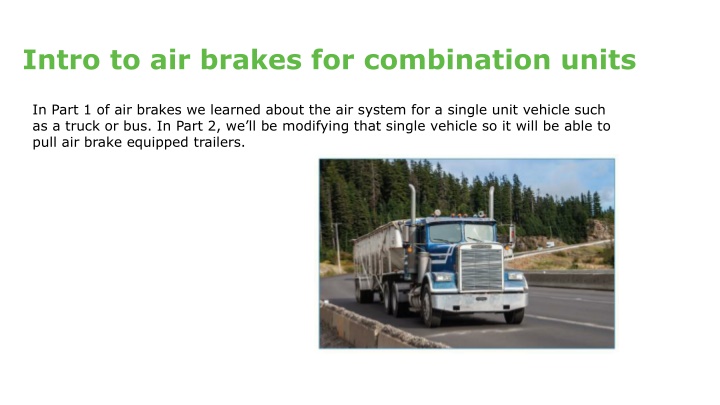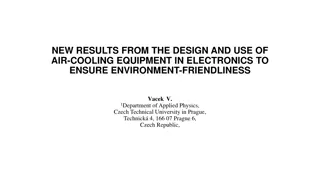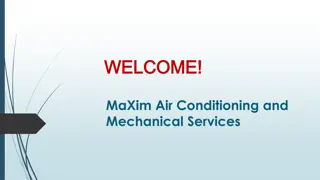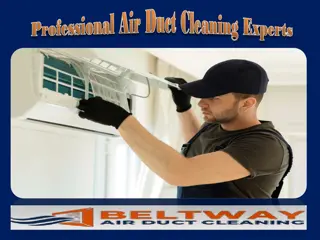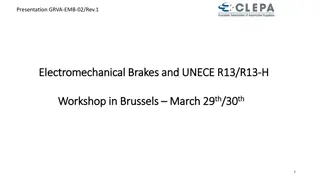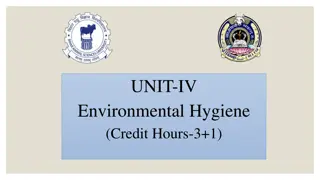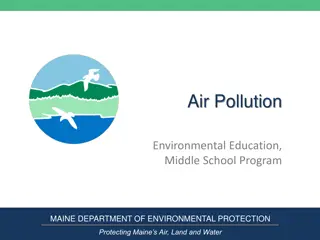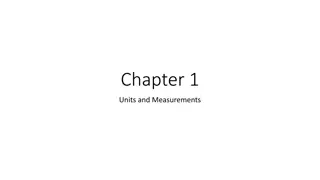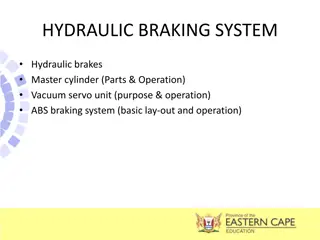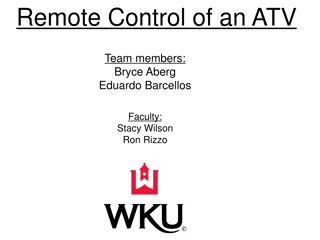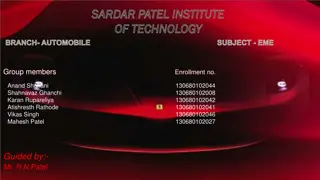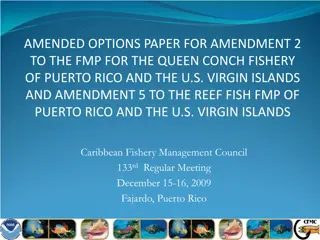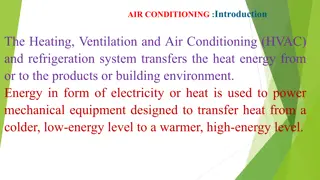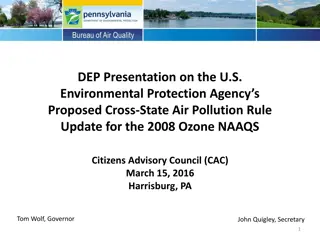Introduction to Air Brakes for Combination Units
In this guide, we delve into the world of air brakes for combination units, specifically focusing on the modifications required to enable a single vehicle such as a truck or bus to pull air brake-equipped trailers. The content covers essential valves, components, failure scenarios, and operational aspects of air brake systems in combination units, providing valuable insights into tractor-trailer operation dynamics.
Download Presentation

Please find below an Image/Link to download the presentation.
The content on the website is provided AS IS for your information and personal use only. It may not be sold, licensed, or shared on other websites without obtaining consent from the author.If you encounter any issues during the download, it is possible that the publisher has removed the file from their server.
You are allowed to download the files provided on this website for personal or commercial use, subject to the condition that they are used lawfully. All files are the property of their respective owners.
The content on the website is provided AS IS for your information and personal use only. It may not be sold, licensed, or shared on other websites without obtaining consent from the author.
E N D
Presentation Transcript
Intro to air brakes for combination units In Part 1 of air brakes we learned about the air system for a single unit vehicle such as a truck or bus. In Part 2, we ll be modifying that single vehicle so it will be able to pull air brake equipped trailers.
Air brakes valves for combination units To convert a truck to a tractor (and be able to tow a trailer) we must add these key valves. Note that this is not a complete list of valves. Trailer control valve - generally a red button inside the cab. Tractor protection valve. Also an optional valve commonly found in trucks - a hand valve to control the service brakes on the trailer independently from the foot valve. Air lines and gladhands - to deliver the air to the trailers to be towed.
Air brakes components added This diagram shows two service reservoirs, the dual foot valve, and the components that are added to a tractor with a dual air system to tow a trailer with air brakes. 3
Failure in primary system This diagram shows a tractor with a dual air system where there has been a failure in the primary air system on the tractor. 4
Air brake valves working together This diagram shows how the tractor protection valve and the trailer air supply valve act together. 5
Bobtailing Driving a tractor without a trailer attached is called bobtailing. Because a bobtail tractor has very little weight over the rear drive axles, it s very easy to lock up the rear brakes, even with a light brake application. To help prevent this unwanted lockup and to increase control, some tractors are equipped with a bobtail proportioning system. 6
Trailer system components A trailer system has many of the components found on a truck system: foundation brakes air chambers air reservoirs control valves The only major item not found on a trailer air system is an air compressor. Air for the trailer must come from the tractor. 7
Air brakes trailer components cont. There are two air line connections between the tractor and the trailer: The air line that supplies the trailer reservoirs with air at full tractor reservoir pressure is called the supply line, or the emergency line. The line that carries the control signal from the tractor is called the control line or commonly called the service line. 8
Air brakes trailer air system There are two types of trailer air systems those that use spring parking brakes and those that don t. Although most current trailers use spring parking brakes, some older trailers and converter dollies aren t equipped with spring parking brakes. 9
Trailer with spring parking brakes charging This diagram shows a typical trailer system that uses spring parking brakes for parking and for emergency (breakaway) stopping. 10
Air brakes trailer spring brake valves The tractor is delivering air through the supply line to the trailer spring brake valve. The spring parking brake valve directs air to fill the reservoir(s) and to release the spring parking brakes. 11
Trailer with spring parking brakes service brake application In this diagram, a control signal from the tractor has been sent through the control line to the trailer s relay valve. 12
Trailer with spring parking brakes dynamited This diagram shows a ruptured supply line 13
Braking combination units When making a foot valve brake application, there will be an equal amount of air supplied to the service brakes on the tractor and the trailer. If an application is made with the foot and a greater one with the hand valve, the service brakes on the trailer will be applied with more force. 14
Trailer ABS air brake systems Trailer ABS systems use similar components as those on trucks and tractors The ECU may be powered from the stop lamp circuit, or may have a dedicated power source through the electrical connector. Trailers with ABS air brakes will also have an indicator visible in the tractor s mirror to indicate if the system s not functioning properly. This warning light may be mounted on the front left side of the trailer or on the rear left side of the trailer. On some air brake systems, there may be a trailer ABS warning indicator on the dashboard of the tractor. 15
Combination unit air pre-trip On the following slides, we ll go over the steps to perform a pre-trip on a tractor-trailer unit. You ll notice that much of the information is the same as the single unit. 16
Getting started Before getting started: make sure you re safe and seen block the wheels and place the transmission in low gear. 17
Reservoirs Check to see if you have some air on the air gauges. Drain the supply tank (wet tank) if equipped. Recheck the gauges to see if the air in the reservoirs remained the same. This confirms the one-way check valve is working. 18
Under the hood foundation brakes Open the hood and check the travel of the slack adjustor. Check the air line coming out to the brake chamber for cracks or damage. Check the brake chamber to ensure it is in good condition and secure. Repeat this on both sides. 19
Under the hood - compressor Check the compressor to ensure it is secure and the discharge line (the main line of the compressor) is in good condition. Check that all other air lines under the hood are secure and in good condition. Check that there are no coolant or oil leaks. 20
In cab Get into the truck, confirm the vehicle is in neutral, and start the engine. Release the brakes by pushing in the yellow and red button. 21
In cab check governor operation Press and release the brake pedal (called fanning down) to lower the air no lower then 80 psi. Allow the compressor to build to maximum air pressure between 105-135. Next, lower the air 20 psi to confirm the governor puts the compressor into the reload stage. This will be determined when the needles begin to climb. Continue to lower the air pressure further by fanning down to check the low air warning. It must come on by 60 psi. Continue to lower the air pressure until the trailer supply valve closes. This must happen between 45-20 psi. Exit the cab and confirm the trailer parking brake circuit has engaged. 22
Check parking brake on trailer is engaged Walk to the rear of the trailer to visually check that the push rods have extended, engaging the parking brake circuit. 23
Disconnect air lines Return to the front of the trailer and disconnect the air lines. 24
Check tractor protection valve Once the air lines are disconnected, make a brake application to confirm that the tractor protection valve is working. This will be confirmed if there is no air escaping from the air lines while the brake pedal is being held. 25
Continue compressor check Re-enter the cab to complete the compressor check. Start the engine and when the first needle hits 50 psi start timing. The compressor must build from 50 to 90 psi in under three minutes at an rpm of 1000-1200. Stop the timing when the last needle goes through 90 psi. Release the parking brakes, push the trailer supply valve, and continue to build to maximum air to confirm that the governor puts the compressor into the unload stage between 105 and 135 psi. 26
Leak test With the brakes released, the engine off and the window open to hear any audible air leaks, make a firm brake application. To perform a leak test, hold a firm brake application for one minute. After the initial application, the system must not lose any more then four psi during that time with a single trailer and no more then six psi with two trailers. Listen out the window for any audible air leaks. Once completed, confirm there s a minimum of 100 psi in the reservoirs and the brakes remained released. Put the transmission in low gear and exit the vehicle. 28
Under tractor Go under the rear of the vehicle to check that air tanks are secure and air lines are tied up and secure. Then, move back to the rear wheels to perform the same checks as at the front. 29
Check air lines and pushrods Check at each wheel that the air lines going into the brake chambers are in good condition, the brake chambers are in good condition, and that you have the correct pushrod travel. Use either the pry bar method or the applied stoke method. 30
Apply the parking brakes Exit from under the vehicle and apply the brakes by pulling the yellow button. 31
Remove wheel blocks Once the brakes are applied remove the wheel blocks. 32
Four-way brake response test Enter the vehicle and confirm the transmission is in neutral. 1. Start the engine, place in low gear with the parking brakes applied on the tractor and the trailer brakes released. Try to move the vehicle to confirm the parking brakes are holding the tractor. 2. Release the tractor parking brakes and apply the trailer parking brakes. Try to move the vehicle to confirm the parking brakes are holding on the trailer. 3. If yes, release the parking brakes on the tractor and trailer and allow the vehicle to roll ahead. Using the foot valve make a brake application to confirm the vehicle will stop. 4. If it stops, again allow the vehicle to roll ahead. Using the hand valve (if equipped) apply the service brakes on the trailer to confirm the vehicle stops. 33
